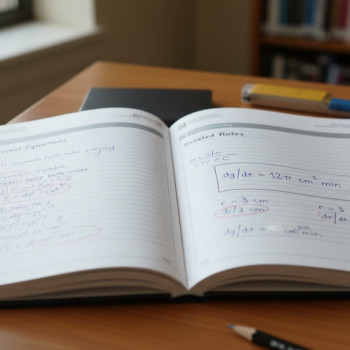Why Composition and Inverses Matter — and Why You Should Care
Composition and inverse functions are a pair of ideas that show up again and again in Precalculus and on AP exams. They’re elegant, powerful, and deceptively simple-looking. If you think of functions as machines that take inputs and produce outputs, composition is connecting machines in series, and inverses are the machines that undo each other. Mastering these topics gives you fluency to manipulate formulas, invert relationships in physics or economics problems, and tackle algebraic traps faster on test day.

Big Picture Concepts — Rules You Want Memorized
Before diving into canonical problems, keep these core ideas at the front of your mind.
- Composition notation: (f o g)(x) means f(g(x)). Apply g first, then f.
- Domain awareness: The domain of f o g is the set of x values in the domain of g for which g(x) is in the domain of f.
- Inverse definition: f^{-1} is the inverse of f if f(f^{-1}(x)) = x and f^{-1}(f(x)) = x (on the appropriate domains).
- One-to-one requirement: Only one-to-one functions (injective) have true inverses that are functions—this can be tested with the horizontal line test on graphs.
- Algebraic inversion strategy: To find f^{-1}(x) solve y = f(x) for x in terms of y, then swap x and y.
Canonical Problem Types You Will See
Below are canonical problem types with targeted strategies and worked examples. Walk through each slowly at first—then practice variations until the steps become automatic.
Type A — Evaluate a Composition at a Point
Typical prompt: Given f(x) and g(x), find (f o g)(a) or (g o f)(b).
Strategy:
- Compute the inner function at the given input.
- Plug that result into the outer function.
- Watch domain and arithmetic carefully.
Example:
Let f(x) = 2x + 3 and g(x) = x^2. Find (f o g)(-2).
Step 1: g(-2) = (-2)^2 = 4. Step 2: f(4) = 2(4) + 3 = 11. So (f o g)(-2) = 11.
Type B — Algebraic Composition Simplification
Typical prompt: Given f(x) and g(x), find (f o g)(x) in simplified form.
Strategy:
- Replace x in f with g(x), then simplify algebraically.
- Be methodical: expand only when necessary; factor at the end if helpful.
Example:
Let f(x) = sqrt(x + 1) (principal square root) and g(x) = 3x – 2. Compute (f o g)(x) and state its domain.
Compute: (f o g)(x) = f(3x – 2) = sqrt(3x – 2 + 1) = sqrt(3x – 1). Domain demands 3x – 1 ≥ 0 → x ≥ 1/3.
Type C — Find an Inverse Function Algebraically
Typical prompt: Given a one-to-one f(x), find f^{-1}(x).
Strategy:
- Write y = f(x).
- Solve the equation for x in terms of y.
- Swap x and y: the new y (or notation f^{-1}(x)) is the inverse.
- State domain and range carefully—domain of f^{-1} = range of f.
Example:
f(x) = (2x – 5)/3. Solve y = (2x – 5)/3 for x: multiply both sides by 3: 3y = 2x – 5 → 2x = 3y + 5 → x = (3y + 5)/2. Swap variables: f^{-1}(x) = (3x + 5)/2.
Type D — Prove or Disprove That f and g are Inverses
Typical prompt: Show whether f(g(x)) = x and g(f(x)) = x hold (for all x in suitable domains).
Strategy:
- Compute both compositions symbolically. If both simplify to x (on valid domains) they are inverses.
- Remember to check domains; sometimes one composition equals x but the other doesn’t across the full domain, so they are not mutual inverses.
Example:
Let f(x) = (x – 1)/(x + 2) and g(x) = (2x + 1)/(1 – x). Test whether they are inverses.
You compute f(g(x)) and g(f(x)). The algebra is messy but mechanical—carry out substitution, simplify, and check domain exclusions (like values that make denominators zero). If either composition fails to simplify to x or there are domain mismatches, they aren’t inverses.
Worked Canonical Problems — Step-by-Step
We’ll step through three representative problems that combine composition and inversion ideas frequently tested and useful in higher math.
Problem 1 — Nested Composition and Domain
Let f(x) = sqrt(x) and g(x) = 4 – x. Find (f o g)(x) and its domain. Then find (g o f)(x) and its domain.
Solution:
- (f o g)(x) = f(4 – x) = sqrt(4 – x). Domain requires 4 – x ≥ 0 → x ≤ 4.
- (g o f)(x) = g(sqrt(x)) = 4 – sqrt(x). Domain requires sqrt(x) defined → x ≥ 0. So domain is x ≥ 0. There is no further restriction from g because 4 – sqrt(x) is defined for all real sqrt(x).
Notice how composition order changed the domain. This subtlety is a common trap on exams—read carefully which function comes first.
Problem 2 — Find an Inverse That’s a Function
Given f(x) = x^3 + 1. Find f^{-1}(x) and state the domain and range.
Solution:
- Write y = x^3 + 1. Solve for x: y – 1 = x^3 → x = cube_root(y – 1).
- Swap variables: f^{-1}(x) = cube_root(x – 1).
- Since cubic is one-to-one over all real numbers, domain and range for both functions are all real numbers.
Key point: odd-degree polynomials with monotonic behavior are invertible across R, whereas quadratics are not unless restricted.
Problem 3 — Composition with the Inverse
Let f(x) = 5x – 2. Find f^{-1}(x), then compute (f o f^{-1})(x) and (f^{-1} o f)(x) to verify they equal x (with domain notes).
Solution:
- Find inverse: y = 5x – 2 → 5x = y + 2 → x = (y + 2)/5 → f^{-1}(x) = (x + 2)/5.
- (f o f^{-1})(x) = f((x + 2)/5) = 5*((x + 2)/5) – 2 = x + 2 – 2 = x.
- (f^{-1} o f)(x) = f^{-1}(5x – 2) = ((5x – 2) + 2)/5 = 5x/5 = x.
Because f is linear with nonzero slope, it’s one-to-one and the inverses behave perfectly on all real numbers.
Table: Quick Reference for Typical Function Forms and Their Inverses
This compact table is a memory aid—learn the patterns and practice a few examples of each.
| Function f(x) | Typical Inverse f^{-1}(x) | Domain / Range Notes |
|---|---|---|
| f(x) = ax + b (a ≠ 0) | f^{-1}(x) = (x – b)/a | Domain and range: all real numbers |
| f(x) = x^3 + c | f^{-1}(x) = cube_root(x – c) | All real numbers (odd polynomial) |
| f(x) = x^2 (restricted x ≥ 0) | f^{-1}(x) = sqrt(x) | Domain of inverse: x ≥ 0 |
| f(x) = sqrt(x – h) + k | f^{-1}(x) = (x – k)^2 + h, with domain x ≥ k | Requires range restricted to x ≥ k for inverse to be a function |
| f(x) = (ax + b)/(cx + d) (ad – bc ≠ 0) | f^{-1}(x) = ( -dx + b )/( cx – a ) (after algebra) | Watch for vertical asymptotes and excluded values |
Common Traps and How to Avoid Them
- Mixing order: (f o g)(x) is not the same as (g o f)(x). Always substitute carefully and write intermediate steps.
- Domain oversight: Forgetting that the inner function’s outputs must be valid inputs for the outer function is a frequent mistake—check domains after composing.
- Assuming invertibility: Not every function has an inverse that is a function. Use the horizontal line test or algebraic checks and consider restricting domains when appropriate.
- Algebra slips: Inverse-finding often requires algebraic manipulation that invites sign errors—perform a quick sanity check by composing the inverse back into the original.
Exam-Ready Strategies — Speed, Accuracy, and Confidence
On an AP-style exam or a timed Precalculus test, you’ll win by combining conceptual clarity with efficient, reliable methods.
- Annotate the order: When you see (f o g)(x), write a tiny arrow or bracket: x -> g -> f. It only takes a moment and prevents order errors.
- Check domains immediately: For composition problems with radicals, fractions, or logs, write the domain constraint next to your intermediate results.
- Use quick inverse checks: After you find an inverse algebraically, plug it into the original and verify composition reduces to x (within the stated domain). A brief check saves points.
- Practice canonical variations: Create a problem set for yourself with linear, polynomial, radical, rational, and exponential/logarithmic types. Exposure builds intuition.
- Timebox harder algebra: If you get stuck manipulating a complicated rational expression, move on and return if time permits—on the AP there are many solvable points elsewhere. Flag the question and don’t panic.
Study Plan — 4 Weeks to Mastery
Here’s a focused study plan that integrates practice, review, and targeted feedback. Modify to suit your schedule.
- Week 1 (Foundations): Review function notation, domain/range, and composition basics. Do 10 problems each day on evaluation and composition at points.
- Week 2 (Inverses): Learn algebraic inversion technique. Practice linear, cubic, and restricted quadratic inverses. Verify inverses by composing back.
- Week 3 (Mixed Practice): Combine composition + inverse problems: find f^{-1} and then compute (f o f^{-1}). Vary forms (radical, rational, exponential/log if covered).
- Week 4 (Exam Simulation): Take timed sections mixing composition and inverse questions. Review common mistakes and do targeted drills on weak areas.
Tip: Short, focused daily practice (20–40 minutes) beats occasional marathon sessions. Keep a notebook of mistakes to avoid repeating them.
How Personalized Tutoring Can Help — A Natural Fit
If you find yourself plateauing, personalized help accelerates progress. Sparkl’s personalized tutoring offers 1-on-1 guidance, tailored study plans, expert tutors, and AI-driven insights to identify weak spots and suggest targeted practice. For example, a tutor could watch you work through a tricky rational-inverse problem, point out subtle algebraic steps that consistently cause errors, and provide scaffolded problems that build your skill without frustration.
Practice Set — Try These (Answers Below)
Work these out without a calculator where possible. Time yourself: 30–40 minutes for the whole set.
- 1) f(x) = x^2 + 4, with f restricted to x ≥ 0. Find f^{-1}(x).
- 2) f(x) = 3x – 7, g(x) = 2/x. Compute (f o g)(x) and state its domain.
- 3) Given f(x) = (x – 1)/(x + 2). Find f^{-1}(x) (carry out algebra carefully).
- 4) If f(x) = e^{x} (if exponential covered in class), what is f^{-1}(x)? How does composition f(f^{-1}(x)) behave?
- 5) Let f(x) = sqrt(2x + 3). Compute (f^{-1} o f)(x) and describe domain restrictions.
Answers (brief)
- 1) f^{-1}(x) = sqrt(x – 4), domain x ≥ 4.
- 2) (f o g)(x) = 3*(2/x) – 7 = 6/x – 7. Domain: x ≠ 0.
- 3) Solve y = (x – 1)/(x + 2): y(x + 2) = x – 1 → yx + 2y = x – 1 → bring x-terms together → yx – x = -1 – 2y → x(y – 1) = – (1 + 2y) → x = – (1 + 2y)/(y – 1). Swap: f^{-1}(x) = – (1 + 2x)/(x – 1). (You can multiply numerator and denominator by -1 to get (1 + 2x)/(1 – x) if preferred.)
- 4) f^{-1}(x) = ln(x). Composition f(f^{-1}(x)) = e^{ln(x)} = x for x > 0 (domain/range note).
- 5) Inverse is f^{-1}(x) = (x^2 – 3)/2 with domain x ≥ 0 for original; (f^{-1} o f)(x) = x for x in domain where operations are valid (here x where 2x + 3 ≥ 0 → x ≥ -3/2).
Final Tips — What Top Students Do Differently
- They write clean intermediate steps so errors are easy to spot and correct under time pressure.
- They memorize a short list of inverse-patterns (linear, cubic, sqrt/quadratic with restriction, log/exponential) and practice transitions among them.
- They simulate test conditions regularly and review mistakes the next day rather than immediately—spacing helps retention.
- They seek targeted feedback when stuck—whether from a teacher, peer, or a personalized tutoring program such as Sparkl that can customize practice and track progress.

Parting Thought — Composition and Inverse Are Tools, Not Obstacles
When you view composition as chaining machines and inverses as undoing operations, the algebra becomes less mysterious and more like a puzzle with reliable moves. Practice deliberately, check domains, and use verification (compose back) as your safety net. If you combine steady practice with occasional targeted tutoring—especially 1-on-1 feedback that addresses your personal sticking points—you’ll find these topics move from “tricky” to “comfortable.”
Good luck, and remember: small, consistent improvements add up. Tackle a few canonical problems every day, review mistakes, and don’t hesitate to ask for a bit of personalized help to accelerate your gains.





















No Comments
Leave a comment Cancel